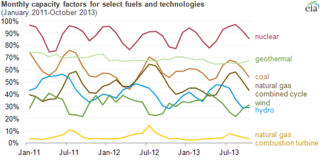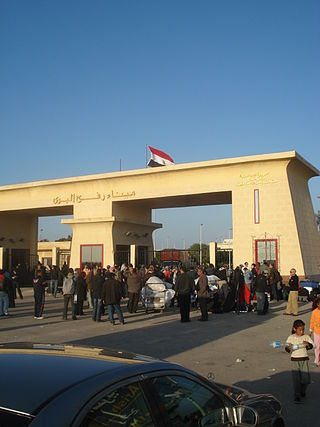
The Gaza Strip, or simply Gaza, is a polity and the smaller of the two Palestinian territories. On the eastern coast of the Mediterranean Sea, Gaza is bordered by Egypt on the southwest and Israel on the east and north.

The Gaza Strip smuggling tunnels are smuggling tunnels that had been dug under the Philadelphi Route along the Egypt–Gaza border. They were dug to subvert the blockade of the Gaza Strip to smuggle in fuel, food, weapons and other goods into the Gaza Strip. After the Egypt–Israel peace treaty of 1979, the town of Rafah, in the southern Gaza Strip, was split by this buffer zone. One part is located in the southern part of Gaza, and the smaller part of the town is in Egypt. After Israel withdrew from Gaza in 2005, the Philadelphi Corridor was placed under the control of the Palestine Authority until 2007, when Hamas seized power in 2007, and Egypt and Israel closed borders with the Gaza Strip.

Israel Electric Corporation is the largest supplier of electrical power in Israel and the Palestinian territories. The IEC builds, maintains, and operates power generation stations, sub-stations, as well as transmission and distribution networks in Israel.

The net capacity factor is the unitless ratio of actual electrical energy output over a given period of time to the theoretical maximum electrical energy output over that period. The theoretical maximum energy output of a given installation is defined as that due to its continuous operation at full nameplate capacity over the relevant period. The capacity factor can be calculated for any electricity producing installation, such as a fuel consuming power plant or one using renewable energy, such as wind, the sun or hydro-electric installations. The average capacity factor can also be defined for any class of such installations, and can be used to compare different types of electricity production.

The 2006 Gaza–Israel conflict, known in Israel as Operation Summer Rains, was a series of battles between Palestinian militants and the Israel Defense Forces (IDF) during summer 2006, prompted by the capture of Israeli soldier Gilad Shalit by Palestinian militants on 25 June 2006. Large-scale conventional warfare occurred in the Gaza Strip, starting on 28 June 2006, which was the first major ground operation in the Gaza Strip since Israel's unilateral disengagement plan was implemented between August and September 2005.

On 23 January 2008, Hamas militants in the Gaza Strip set off an explosion near the Rafah border crossing, destroying part of the 2003 wall. The United Nations estimates that as many as half the 1.5 million population of the Gaza Strip crossed the border into Egypt seeking food and supplies. Due to fears that militants would acquire weapons in Egypt, Israeli police went on increased alert.
The Gaza–Israel conflict is a localized part of the Israeli–Palestinian conflict beginning in 1948, when 200,000 Palestinians fled or were expelled from their homes, settling in the Gaza Strip as refugees. Since then, Israel has fought 15 wars against the Gaza Strip. The number of Gazans killed in the most recent 2023 war — 27,000 — is higher than the death toll of all other wars of the Arab-Israeli conflict.

A blockade has been imposed on the movement of goods and people in and out of the Gaza Strip following Hamas's takeover in 2007, led by Israel and supported by Egypt. The blockade's current stated aim is to prevent the smuggling of weapons into Gaza, although previously stated motivations have included exerting economic pressure on Hamas. Human rights groups have described the blockade as illegal and a form of collective punishment as it restricts the flow of essential goods, contributes to economic hardship, and limits the freedom of movement for Gaza's residents. The blockade and its effects have led to the territory being described as an "open-air prison".

Energy in Armenia is mostly from natural gas. Armenia has no proven reserves of oil or natural gas and currently imports most of its gas from Russia. The Iran-Armenia Natural Gas Pipeline has the capacity to equal imports from Russia.

The use of solar energy began in Israel in the 1950s with the development by Levi Yissar of a solar water heater to address the energy shortages that plagued the new country. By 1967 around 5% of water of households were solar heated and 50,000 solar heaters had been sold. With the 1970s oil crisis, Harry Zvi Tabor developed the prototype of the solar water heater now used in over 90% of Israeli homes. There are over 1.3 million solar water heaters installed as a result of mandatory solar water heating regulations.
There are multiple humanitarian, medical, economic, and industrial effects of the 2008–2009 Gaza War which started with the Israeli air strikes on 27 December 2008 and ended on 18 January with a cease-fire implemented unilaterally by Israel, and later the same day by Hamas and other Palestinian factions. The cease-fire followed twenty-two days of bombardment by land, sea and air which left over 1,300 Palestinians dead and over 5,000 injured, and the death of 13 Israelis. The United Nations Development Programme warned that there will be long-term consequences of the attacks on Gaza because the livelihoods and assets of tens of thousands of Gaza civilians have been affected.

The economy of the Gaza Strip was dependent on small industries and agriculture. After years of decline, the Gaza economy experienced some growth in the late 2000s, boosted by foreign aid. According to the International Monetary Fund, the economy grew 20 percent in 2011, and the per capita gross domestic product increased by 19 percent.

The governance of the Gaza Strip since the Hamas takeover of the Gaza Strip in June 2007 has been carried out by Hamas. The Hamas government in Gaza was led by Ismail Haniyeh from 2007 until February 2017, when Haniyeh was replaced as leader of Hamas in the Gaza Strip by Yahya Sinwar. As of November 2023, Yahya Sinwar continues to be the leader of Hamas in the Gaza Strip. Due to the ongoing Israel–Hamas war, Hamas lost control of most of the northern part of the Gaza Strip.

Most energy in Israel comes from fossil fuels. The country's total primary energy demand is significantly higher than its total primary energy production, relying heavily on imports to meet its energy needs. Total primary energy consumption was 304 TWh (1.037 quad) in 2016, or 26.2 million tonne of oil equivalent.

The 2014 Gaza War, also known as Operation Protective Edge, and Battle of the Withered Grain, was a military operation launched by Israel on 8 July 2014 in the Gaza Strip, a Palestinian territory that has been governed by Hamas since 2007. Following the kidnapping and murder of three Israeli teenagers in the West Bank by Hamas-affiliated Palestinian militants, the Israel Defense Forces (IDF) initiated Operation Brother's Keeper, in which some 350 Palestinians, including nearly all of the active Hamas militants in the West Bank, were arrested. Hamas subsequently fired a greater number of rockets into Israel from the Gaza Strip, triggering a seven-week-long conflict between the two sides. It was one of the deadliest outbreaks of open conflict between Israel and the Palestinians in decades. The combination of Palestinian rocket attacks and Israeli airstrikes resulted in over two thousand deaths, the vast majority of which were Gazan Palestinians. This includes a total of six Israeli civilians who were killed as a result of the conflict.
Palestine produces no oil or natural gas and is predominantly dependent on the Israel Electric Corporation (IEC) for electricity. According to UNCTAD, the Palestinian Territory "lies above sizeable reservoirs of oil and natural gas wealth" but "occupation continues to prevent Palestinians from developing their energy fields so as to exploit and benefit from such assets." In 2012, electricity available in West Bank and Gaza was 5,370 GW-hour, while the annual per capita consumption of electricity was 950 kWh. National sources only produce 445 GWh of electricity, supplying less than 10% of demand. The only domestic source of energy is the disputed Gaza Marine gas field, which has not yet been developed. Palestinian energy demand increased rapidly, increasing by 6.4% annually between 1999 and 2005. Future consumption of electricity is expected to reach 8,400 GWh by 2020 on the expectation that consumption will increase by 6% annually.

The energy crisis in Armenia, popularly known as the dark and cold years, refers to the energy crisis in Armenia during the 1990s, when the newly independent Armenia's population lived in shortage of energy and basic consumer goods. Although it only lasted 3–4 years, it left a deep impact and impression. Local people have dubbed the years from 1992 to 1995 in different ways, such as "hungry", "cold", and "bad", but the most common title used is "the dark".
The Gaza electricity crisis is an ongoing and growing electricity crisis faced by nearly two million residents of the Gaza Strip, with regular power supply being provided only for a few hours a day on a rolling blackout schedule. Some Gazans and government institutions use private electric generators, solar panels and uninterruptible power supply units to produce power when regular power is not available.

The Sojitz Kelanitissa Power Station, is privately owned 172 MW diesel-fired combined cycle power station located in Kelanitissa, in the city of Colombo, Sri Lanka. It is owned by Sojitz Kelanitissa Private Limited, a subsidiary of Sojitz Corporation. The power station is located adjacent to the Kelanitissa Power Station, which is a separate government-owned power station.
On 9 October 2023, Israel intensified the blockade of the Gaza Strip in response to the beginning of the Israel–Hamas war and the 7 October attack on Israel by Hamas-led Palestinian militants. Israel's Defense Minister Yoav Gallant announced a "total blockade", blocking the entry of food, water, medicine, fuel and electricity. Israel stated that the blockade would not be lifted until the hostages abducted by Hamas are returned, while Hamas stated that it would release all Israeli hostages in exchange for the release of all Palestinian prisoners by Israel. Later, Gallant changed his position of a complete blockade. On 18 October 2023, United States President Joe Biden announced that Israel and Egypt had agreed to allow humanitarian aid to enter the Gaza Strip, with the first supplies entering on 21 October 2023. The blockade exacerbated Gaza's humanitarian crisis.















